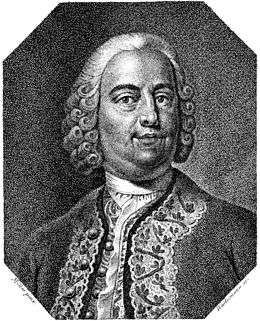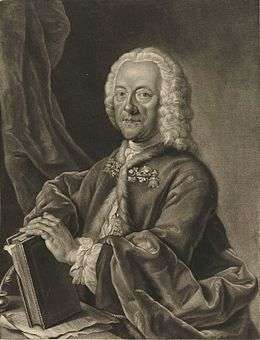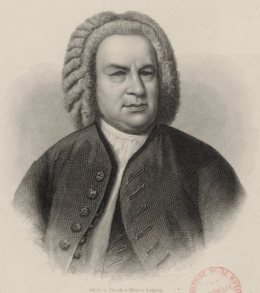Wer ist der, so von Edom kömmt
Wer ist der, so von Edom kömmt is a pasticcio Passion oratorio based on compositions by Carl Heinrich Graun, Georg Philipp Telemann, Johann Sebastian Bach and others. The pasticcio was assembled around 1750.
The only extant manuscript of the Pasticcio was written by Johann Christoph Farlau and an unknown scribe. Farlau was a pupil of Johann Christoph Altnickol, Bach's son-in-law. Since a reliable differentiation between the handwriting of the master and the pupil was only done in the early 21st century, older scholarship generally attributes the realisation of the Pasticcio to Altnickol and/or indicates Altnickol as the composer of the movements that can not be attributed to other composers.
In the second half of the 20th century Bach scholarship turned its attention to the pasticcio as it was possibly Bach's elusive "5th Passion", and for containing previously unknown work by the composer (BC D 10).
History



The backbone of the Wer ist der, so von Edom kömmt pasticcio is Ein Lämmlein geht und trägt die Schuld, a Passion cantata by Carl Heinrich Graun: 31 of the pasticcio's 42 movements derive from this composition. The first two movements of the pasticcio are choral movements composed by Telemann. Three movements are linked to Bach. For the remaining six movements no composer is known.[1]
The text authors of the pasticcio and its components are largely unknown, apart from those of the Lutheran hymn texts, for instance Paul Gerhardt's "O Haupt voll Blut und Wunden" (movement 18), and Michael Weiße's "Christus, der uns selig macht" (movements 2, 24, 27, 30, 38, 40 and 42). For the free verse no librettist is known. There is no direct quote from the Gospel's Passion texts: the Passion's story isn't told by an Evangelist role in recitatives, nor in direct speech by any of its characters such as a vox Christi or turba choruses, but exclusively hinted at by the reflective texts of the free verse and the chorales. Closest to a Passion narrative in this sense are the interspersed stanzas of "Christus, der uns selig macht", which recall successive scenes of Christ's Passion. Other Biblical models can be indicated for some of the lyrics, for instance Isaiah 57:1–2 ("The righteous perishes") for the Bach-movement No. 39, which for its German text does however not use the translation of the Luther Bible, but an alternative translation by an unknown text author.
Ein Lämmlein geht und trägt die Schuld, GraunWV B:VII:4
Movements 2–31 and 33 of Graun's Passion cantata Ein Lämmlein geht und trägt die Schuld, GraunWV B:VII:4, reappear in the pasticcio as movements 3–18, 21–23, 25–26, 28–29, 31–37 and 41.[1]
Graun's Passion cantata was composed in Braunschweig between 1725 and 1735, and was popular and widely spread for over a century after its composition.[2][3][4][5]
Telemann
The opening chorus "Wer ist der, so von Edom kömmt" and the ensuing chorale "Christus, der uns selig macht" are the first two movements of Telemann's cantata Wer ist der, so von Sodom kommt, TWV 1:1585, which was composed for Palm Sunday.[1][2][6][7]
Bach
Movements 19, 20 and 39 of the pasticcio are linked to Bach, the last of these three movements also to Bach's predecessor in Leipzig, Johann Kuhnau. In the Bach Compendium these three movements are given the number D 10.
"Herr Jesu Christ, wahr' Mensch und Gott", BWV 127/1 (variant)
The opening chorus of Bach's cantata Herr Jesu Christ, wahr' Mensch und Gott, BWV 127 appears revised, and transposed to E-flat major, as 19th movement in the Pasticcio.[2][8] The original cantata was first performed on Estomihi Sunday (the last Sunday before lent), 11 February 1725 in Leipzig.[9]
Arioso "So heb ich denn mein Auge sehnlich auf", BWV 1088
The arioso for bass voice "So heb ich denn mein Auge sehnlich auf" is the 20th movement of the pasticcio. In the second half of the 20th century it was attributed to Bach on stylistic grounds, and added as one of the Nachträge (later additions) to the Bach-Werke-Verzeichnis, under the number 1088. In BWV2a (1998) it was added to the 4th chapter (Passions and Oratorios).[10][11]
"Der Gerechte kömmt um", BC C 8
"Der Gerechte kömmt um", the 39th movement of the pasticcio, is an arrangement for SSATB chorus and instrumental ensemble of the Tristis est anima mea motet attributed to Kuhnau. The arrangement is attributed to Bach, and may have been used, in Bach's time in Leipzig, as a funeral motet. 20th-century editions of the Bach-Werke-Verzeichnis don't list this setting of Isaiah 57:1–2 (i.e., BWV deest): in the Bach Compendium it is known as D 10/3 (as part of the pasticcio) or C 8 (as separate motet). In the 21st century the separate motet is mentioned as BWV 1149.[12][13][14][15]
Other movements and realisation of the pasticcio
Movements 24, 27, 30, 38, 40 and 42 of the pasticcio are chorale settings of the second and fourth to eighth verse of the hymn "Christus, der uns selig macht", the first verse of which had appeared in Telemann's setting in the second movement of the pasticcio. The composer of these six movements is unknown, but often assumed to be Altnickol.[16]
The only extant manuscript of the pasticcio originated between 1755 and 1759. Where or when it may have been performed in the 18th century is not known. Who assembled the pasticcio is also not known, but presumably someone in the circle of Bach and/or Altnickol. It is even deemed possible that Bach assembled the pasticcio in the 1740s for a performance in Leipzig (the Passion is in two parts as required for Leipzig Passion performances).[1][2]
Scoring and structure
Wer ist der, so von Edom kömmt is set for soprano (s), alto (a), tenor (t) and bass (b) vocal soloists, and a choir consisting of two soprano parts (S), altos (A), tenors (T) and basses (B). The second soprano choral part only appears in the Bach-movement No. 39. The bass and the soprano vocal soloists sing together with the chorus in the opening movement and in the 34th movement respectively.
The orchestra consists of a basso continuo (Bc), playing in all movements, and a string section (Str), with two violin parts (Vl) and a viola part, playing in most movements. In the tutti movements No. 19 and No. 34 two traversos (Fl) and two oboes (Ob) join the strings and continuo. The traversos also accompany the soprano 1 part in No. 39. Two Oboe d'amore players are required for Aria No. 10 only. Bach-movement No. 20 has two unspecified low instruments: the parts can be played by violoncellos (Vc) or bassoons (Bas).
The first part of the Passion oratorio starts with the two Telemann movements, followed by 16 Graun movements, the last of which, a setting of the "O Haupt voll Blut und Wunden" hymn, concludes the first part. The second part (Nos. 19–42) starts with the first two Bach-movements, followed by further Graun movements interspersed with six stanzas of the "Christus, der uns selig macht" hymn, and as No. 39 the third Bach-movement. Both parts of the Passion-oratorio start with a chorus, and end with a chorale. The choir participates in 19 movements, ten of which are chorale settings.
Soprano, alto and tenor each have three arias. Movement No. 21 is a duet for soprano and alto. The soprano soloist also sings in the tutti movement with chorus No. 34. The bass singer has an aria and an arioso, and sings with the chorus in the opening movement. There are eleven recitatives, some of which with continuo accompaniment exclusively, to be divided among the soprano, alto and tenor soloists.
| No. | type | voices | instr. | incipit | model |
|---|---|---|---|---|---|
| 1. | Chorus | bSATB | 2Ob Str Bc | Wer ist der, so von Edom kömmt | TWV 1:1585/1 |
| 2. | Chorale | SATB | Str Bc | Christus, der uns selig macht | TWV 1:1585/2 |
| 3. | Chorus | SATB | Str Bc | Führwar, er trug unsre Krankheit | GraunWV B:VII:4/2 |
| 4. | Recitative | s | Str Bc | So steigt mein Jesus in Geduld | GraunWV B:VII:4/3 |
| 5. | Aria | s | 2Fl Str Bc | Ihr Tropfen, fallt auf meine Brust | GraunWV B:VII:4/4 |
| 6. | Recitative | t | Bc | Ich weiß, was die ihr selbst gelassene Vernuft | GraunWV B:VII:4/5 |
| 7. | Chorus | SATB | Str Bc | Wir aber hielten ihn für den | GraunWV B:VII:4/6 |
| 8. | Chorale | SATB | Str Bc | Herzliebster Jesu, was hast du verbrochen | GraunWV B:VII:4/7 |
| 9. | Recitative | a [t?] | Bc | Da dich dein Jünger selbst verrät | GraunWV B:VII:4/8 |
| 10. | Aria | a | 2Oba Str Bc | Was an Strafen ich verschuldet | GraunWV B:VII:4/9 |
| 11. | Chorus | SAB | 2Ob Str Bc | Er ist um unserer Missetat willen verwundet | GraunWV B:VII:4/10 |
| 12. | Chorale | SATB | Str Bc | Du trägst die Strafe meiner Schuld | GraunWV B:VII:4/11 |
| 13. | Aria | t | 2Fl Str Bc | Harte Marter, schwere Plagen | GraunWV B:VII:4/12 |
| 14. | Recitative | s | Bc | Jetzt werd ich stark durch Christi Leidenskampf | GraunWV B:VII:4/13 |
| 15. | Aria | s | Str Bc | Nimmst du die Kron der Dornen an | GraunWV B:VII:4/14 |
| 16. | Recitative | a | Bc | Ja, ja, es geh' mir wie es will | GraunWV B:VII:4/15 |
| 17. | Chorus | SATB | Str Bc | Er war der Allerverachteste und Unwerteste | GraunWV B:VII:4/16 |
| 18. | Chorale | SATB | Str Bc | O Haupt voll Blut und Wunden | GraunWV B:VII:4/17 |
| 19. | Chorus | SATB | 2Fl 2Ob Str Bc | Herr Jesu Christ, wahr' Mensch und Gott | BC D 10/1; BWV 127/1 (var.) |
| 20. | Arioso | b | 2Vc [2Bas?] Bc | So heb ich denn mein Auge sehnlich auf | BC D 10/2; BWV 1088 |
| 21. | Duet | sa | Str Bc | Sollt' ich nicht auf Jesum sehen | GraunWV B:VII:4/18 |
| 22. | Recitative | s [a?] | Bc | Die Macht, so meinen Heiland leiden läßt | GraunWV B:VII:4/19 |
| 23. | Aria | a | Str Bc | Hier steht der Grund von meinem Glauben | GraunWV B:VII:4/20 |
| 24. | Chorale | SAB | Str Bc | In der ersten Tagestund | Christus, der uns selig macht, v.2 |
| 25. | Recitative | t | Bc | Der ungerechte Richter selbst | GraunWV B:VII:4/21 |
| 26. | Aria | t | Str Bc | Arme Seel, zerschlagnes Herz | GraunWV B:VII:4/22 |
| 27. | Chorale | SATB | Str Bc | Um sechs ward er nackt und bloß | Christus, der uns selig macht, v.4 |
| 28. | Recitative | a | Bc | Ja, ja, mein Heiland geht die Todesbahn | GraunWV B:VII:4/23 |
| 29. | Aria | a | Str Bc | Ich lose mit, mein köstlich Teil | GraunWV B:VII:4/24 |
| 30. | Chorale | SATB | Bc | Jesus schrie' zur neunten Stund' | Christus, der uns selig macht, v.5 |
| 31. | Recitative | t | Str Bc | Ich sehe meinen Jesum ganz verlassen | GraunWV B:VII:4/25 |
| 32. | Aria | t | Str Bc | Mich entseelt ein banger Schrecken | GraunWV B:VII:4/26 |
| 33. | Recitative | t | Bc | Jedoch mein Glaube stärkt sich wieder | GraunWV B:VII:4/27 |
| 34. | Chorus | sSATB | 2Fl 2Ob Str Bc | Christus hat mit einem Opfer in Ewigkeit vollendet | GraunWV B:VII:4/28 |
| 35. | Aria | b | 2Ob Str Bc | Nun darf ich mich nicht mehr entsetzen | GraunWV B:VII:4/29 |
| 36. | Recitative | s [t?] | Bc | Ist Jesus tot | GraunWV B:VII:4/30 |
| 37. | Aria | s | 2Fl 2Vl Bc | Zerbrich nur, Macht und Pracht der Erden | GraunWV B:VII:4/31 |
| 38. | Chorale | SATB | Str Bc | Da man hat zur Vesperzeit | Christus, der uns selig macht, v.6 |
| 39. | Chorus | SSATB | 2 Fl 2Ob Str Bc | Der Gerechte kömmt um | BC D 10/3; BC C 8 |
| 40. | Chorale | SATB | Str Bc | Da der Tag sein Ende nahm | Christus, der uns selig macht, v.7 |
| 41. | Chorus | SATB | 2Fl Str Bc | Zu meinem Heill, zur Glaubensstärke | GraunWV B:VII:4/33 |
| 42. | Chorale | SATB | Str Bc | O hilf Christe, Gottes Sohn | Christus, der uns selig macht, v.8 |
Reception
In 1964 John W. Grubbs wrote a thesis about the pasticcio.[2][17] The pasticcio was recorded in 1990. In 1997 its score was published by Andreas Glöckner and Peter Wollny. In the 21st century Farlau instead of his teacher Altnickol was identified as one of the scribes of the only extant manuscript (copy) of the pasticcio – which made previous assumptions regarding Altnickol's involvement with the pasticcio somewhat less probable.[1][18] On 17 June 2008 the pasticcio was performed at the Leipzig Bach Festival, conducted by David Timm.[2]
Score editions
Friedrich Hofmeister Musikverlag published the score of the pasticcio in 1997 as Passionskantate "Wer ist der, so von Edom kömmt" (Pasticcio). The editors of this publication were Andreas Glöckner and Peter Wollny.[16] In the New Bach Edition the three Bach movements appeared in Series I (Cantatas), Volume 41, edited by Andreas Glöckner.[19]
The facsimile of the Farlau manuscript (D-B Mus. ms. 8155) is available on-line for instance at the website of the Berlin State Library and at the Bach Digital website.[20][1]
Discography
In 1990 the pasticcio was recorded by Martina Lins (soprano), Ralf Popken (countertenor), Markus Brutscher (tenor), Hans-Georg Wimmer (bass), the Rheinische Kantorei and Das Kleine Konzert, conducted by Hermann Max. The recording was released in 1991 by EMI, and re-issued in 2012.[21]
References
- Bach Digital Source 00000626 at www
.bachdigital .de - Aart van der Wal. Soli Deo Gloria: The Leipzig Bach Festival 2008 – "Part Two: The Music 17th–20th June" at www
.musicweb-international .com - Bernhard Schmidt. Lied - Kirchenmusik - Predigt im Festgottesdienst Friedrich Schleiermachers: Zur Rekonstruktion seiner liturgischen Praxis. Walter de Gruyter, 2002. ISBN 9783110904062, p. 415
- Text zur Passions-Musik "Ein Lämmlein geht und trägt die Schuld etc." von C. H. Graun, und zur Cantate "Davidde penitente" (Der büßende David) von W. A. Mozart. Berlin: Hayn, 1840.
- Robert Schumann, editor. Neue Zeitschrift für Musik Vol. 12, No. 49. Leipzig, 16 June 1840, p. 195
- Georg Philipp Telemann (1681-1767). Wer ist der, so von Sodom kommt TWV 1:1585 at www
.klassika .info - Georg Philipp Telemann Catalogue TWV 01 Cantates d'église Séquence alphabétique S - Z at www
.musiqueorguequebec .ca - Bach Digital Work 00155 at www
.bachdigital .de - Bach Digital Work 00154 at www
.bachdigital .de - (BWV2a) Alfred Dürr, Yoshitake Kobayashi (eds.), Kirsten Beißwenger. Bach Werke Verzeichnis: Kleine Ausgabe, nach der von Wolfgang Schmieder vorgelegten 2. Ausgabe. Preface in English and German. Wiesbaden: Breitkopf & Härtel, 1998. ISBN 3765102490 - ISBN 978-3765102493, p. 271
- Bach Digital Work 01274 at www
.bachdigital .de - Bach Digital Work 01532 at www
.bachdigital .de - Wyant Morton. Questions of authenticity in three motets attributed to Johann Sebastian Bach. The University of Arizona, 1992.
- Melamed, Daniel R. (1995). J.S. Bach and the German Motet. Cambridge University Press. pp. 148–149. ISBN 0-52-141864-X.
- Instrumental and Supplement at www
.bach333 , p. 127.com - Johann Christoph Altnickol, Johann Sebastian Bach, Carl Heinrich Graun, Johann Kuhnau and Georg Philipp Telemann. Passionskantate "Wer ist der, so von Edom kömmt" (Pasticcio) edited by Andreas Glöckner and Peter Wollny. Hofmeister, 1997.
- John Whitfield Grubbs. An eighteenth-century passion pasticcio based on a passion cantata of Carl Heinrich Graun. University of California at Los Angeles, M.A., 1964.
- Peter Wollny, Tennstedt, Leipzig, Naumburg, Halle – Neuerkenntnisse zur Bach-Überlieferung in Mitteldeutschland, Bach-Jahrbuch 2002, pp. 36–47.
- Andreas Glöckner, editor. "Drei Sätze aus der Passionskantate Wer ist der, so von Edom kömmt" in Varia: Kantaten, Quodlibet, Einzelsätze, Bearbeitungen, Volume 41 of New Bach Edition Series I: Cantatas. Bärenreiter, 2000
- Passions-Oratorium "Wer ist der, so von Edom kömmt" (Pasticcio) at Berlin State Library website
- Passions-pasticcio (2) at www
.muziekweb .nl
External links
- G.F. Telemann-C.H. Graun-J.S. Bach-J.C. Altikol-J. Kuhnau Passions-Pasticcio at www
.bach-cantatas .com - (libretto in German) Text-, Liedvorlagen, Bibelkonkordanzen und Besetzungsangaben zu den geistlichen Kantaten, Oratorien & Passionen Johann Sebastian Bachs at www
.s-line .de /homepages /bachdiskographie - Wer ist der, so von Edom kömmt by Johann Christoph Altnikol et al.: Scores at the International Music Score Library Project (IMSLP)